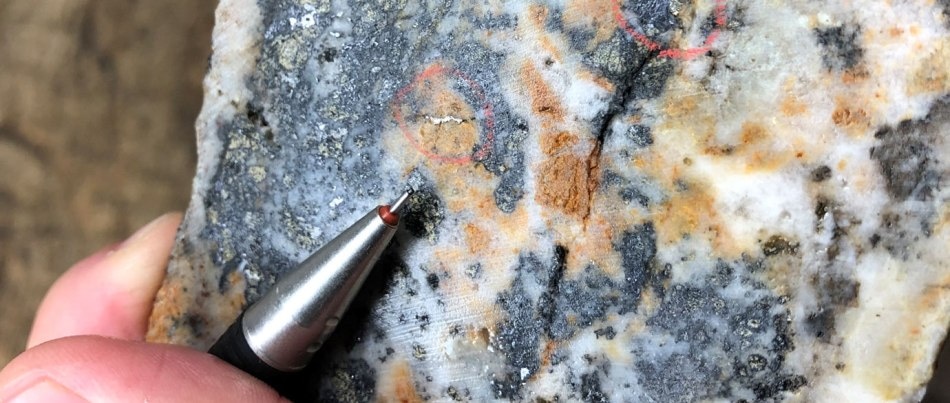Sep 25 2019
Ascot Resources Ltd has reported that its Board of Directors has authorized an expanded, discovery-focused exploration drilling program at its target-abundant Premier Gold Project, situated northwest of Stewart, BC.
 Grab sample with electrum circled in red from the Silver Hill. (Image credit: Ascot Resources Ltd)
Grab sample with electrum circled in red from the Silver Hill. (Image credit: Ascot Resources Ltd)
This program will explore four grass-roots areas and encompasses 3000 to 5000 m of core drilling, in addition to further ground geophysical surveys.
The infill drilling portion of the 2019 campaign has now been completed and we can turn our attention to more exploration-oriented targets. One of the more exciting exploration targets the Company is currently focused on is the Silver Hill prospect, located at the northeastern part of our Premier property.
Derek White, President and CEO, Ascot Resources Ltd
Mr White continued, “We are currently drilling mineralization exposed on surface and in historic trenches that host electrum and very high-grade silver with gold mineralization in an epithermal gold system. This part of the property is located on the boundary between the Dilworth and Bowser basin formations which is an equivalent of the stratigraphic position that hosts the Eskay Creek deposit.”
He further added, “We have also undertaken a geophysical survey that indicated some additional deeper targets to the northeast of Silver Hill which we will continue to explore. Our property adjoins Pretium’s Bowser claim group, where they have been actively exploring with multiple drills throughout this season.”
Additionally, we are pleased to announce programs to test other exciting new exploration targets adjacent to the Silver Coin deposit. Please join me for our conference call (details below) where management will discuss our exploration plans in further detail.
Derek White, President and CEO, Ascot Resources Ltd
Silver Hill
The Silver Hill prospect is situated in the northeastern region of Ascot’s Premier property, hosted within mid-Jurassic felsic volcanic rocks of the Dilworth formation. These rocks were deposited at a comparable time and in an analogous tectonic environment to that which hosts the Eskay Creek deposit.
At present, the company is drilling below the surface expression of a 20 to 25 m-wide zone of breccias, epithermal-style veins, and stockworks that hosts tetrahedrite/tennantite, galena, electrum, and pyrite mineralization.
A sample from a historic trench assayed more than 10000 g/ton Ag and 14 g/ton Au, with 6.49% Pb and 16.55 % Zn. Further north, Ascot has finished a geophysical profile, which has brought about a very exciting target at depth.
This northeast contact extends from Ascot’s property toward the Brucejack Mine, via Pretium’s Bowser claims. There are possible VMS-style targets along the northern area of this trend, including epithermal targets deeper south. These host rocks, which are geologically younger, are located stratigraphically above the early-Jurassic rocks that carry gold mineralization at the Premier, Big Missouri, and Silver Coin deposits.
Discovery-Focused Drill Targets
Further drilling is scheduled northeast of the Silver Coin Deposit, aiming at a historic trench that had a 12.1-m sample grading 8.40 g/ton Au and 23.87 g/ton Ag, which comprised of a 3-m sample grading 27.74 g/ton Au and 26.4 g/ton Ag. Ascot’s exploration program will follow up targets to the northwest and south of Silver Coin with atypical historical values.
The property hosts numerous new targets with the potential of contributing considerably to the company’s present high-grade resources. Ascot’s management will continue to analyze and drill these targets right into the fall season.
Quality Assurance/Quality Control
Analytical work is being performed by SGS Canada Inc (“SGS”). Ascot’s quality-assurance and quality-control program includes the application of analytical blanks to track for cross-contamination, certified reference material standards to evaluate analytical accuracy, and identical samples to measure sampling precision. This is apart from the internal quality assurance program followed by SGS.
SGS dries and weighs the samples. Then, they are crushed to 75% passing 2 mm, with 250 g split and pulverized to 85% passing 75 µm. Samples are processed on-site by a mobile lab provided by SGS and operated by SGS personnel. All splits are transported to SGS in Burnaby. There, all samples are digested using aqua-regia with an ICP-AES finish and fire assay with AA finish for gold.
Samples of more than 100 ppm silver are digested with aqua regia and then volumetrically diluted before an ICP-AES or AA finish (up to 1500 ppm). Samples of more than 1500 ppm silver are fire assayed with a gravimetric finish. Samples of more than 10 ppm gold are fire-assayed with a gravimetric finish. Identified or supposed metallic silver or gold are exposed to “metallics” assays. Sampling and storage are done at a secure facility owned by the company in Stewart.